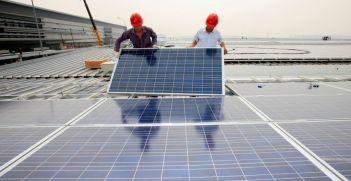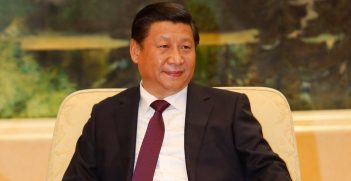An Escape Valve for the Turmoil in Hong Kong?

For weeks, analysts have warned of a “rapid descent into anarchy” in Hong Kong. How did the situation get to where it is today, and what options are there to diffuse the crisis?
Following a series of increasingly violent clashes between police and protesters, last Tuesday the Australian government raised its travel warning for Hong Kong, cautioning travellers to “exercise a high degree of caution” due to the “risk of violent confrontation”. For weeks, analysts have warned of a “rapid descent into anarchy” in Hong Kong, a city embroiled in its tenth week of mass protests that are unprecedented in scale and violence. How did the situation get to where it is today, and what options are there to diffuse the crisis?
While Hong Kong residents took to the streets in early June in a bid to quash a controversial bill that would allow extraditions to mainland China, the protests were never just about the bill itself. Rather, for protesters, the bill was a plot point in a longer storyline in which Hong Kong’s governing elite, steered by Chief Executive Carrie Lam, are more beholden to Beijing than the residents of Hong Kong, and are complicit in seemingly relentless efforts to chip away at Hong Kong’s autonomy under the “one country, two systems” principle. Examples include Beijing’s disqualification of democratically elected lawmakers, the disappearance of Hong Kong booksellers that published texts banned in mainland China, arrests of pro-democracy and pro-independence activists and the erosion of Hong Kong’s legal and territorial autonomy with the posting of Chinese immigration officials at the Hong Kong train station linking to mainland China.
Some might even argue that the government entered the year itching for the confrontation that has erupted. In January, in a ham-fisted attempt at codifying patriotism, China’s peak legislative body, the National People’s Congress, responded to repeated booing of the Chinese national anthem at international matches of Hong Kong’s football team by imposing legislation on Hong Kong that criminalized disrespect for the Chinese national anthem. In early April, just two months before the anti-extradition protests kicked off, nine of the leaders of the 2014 pro-democracy ‘umbrella movement’ were sentenced to prison under vague and anachronistic common law ‘public nuisance’ charges, which carry heavier sentences than similar statutory offences. This followed the governments’ September 2018 decision to ban the pro-independence Hong Kong National Party (HKNP), representing the first prohibition of a political party since the 1997 handover. The government outlawed HKNP not for its record of past violence, but on preventive ‘national security’ grounds that its pro-independence rhetoric could motivate followers to “cause violence and public disorder”. It’s not a stretch of the imagination that Hong Kong residents might interpret Orwellian undertones in this logic, which echoes the government’s rationale for the large-scale detention of Turkic Muslims for “petty” infractions as means to “prevent” terrorist attacks.
The point being—the protests that began in early June haven’t just morphed into something more serious as a result of allegations of excessive use of force by police and the purported unleashing of “thugs for hire” triads to cow public dissent. They have always conjured the ghosts of past grievances and contained the embers of the current chaos. There is a sense particularly among some of the younger generation of protestors that they are at a crossroads in the struggle for the future of democratic rights and freedoms in Hong Kong. Carrie Lam’s labelling the demonstrators “rioters” on 12 June reportedly compounded the “helplessness and despair” that led to the suicide of three young people with links to the protest, and became an inflection point in the turn to more violent tactics. Joshua Wong, a leading student activist in the 2014 umbrella protests who was released from prison on 17 June, summed up the propulsion to violence as born out of a sense that force is the only language the government understands. On Twitter, Wong lamented that the protesters “wanted to make the regime hear Hong Kongers’ voice, and they had no other option. “WE ALREADY TRIED EVERYTHING ELSE.” As the graffiti scrawled on the walls of the ransacked Legislative Council building on July 1 conveyed, “You taught me peaceful protests are futile.”
Part of the problem is that the Chinese Communist Party (CCP), with its narrow focus on socio-economic welfare as opposed to civil and political rights and a nationalist rhetoric that frames protests as an insult to the motherland and Chinese people, has no vocabulary to recognise the grievances expressed by Hong Kong protesters. Scroll through Google images of the protests and it’s clear that the government has a legitimate concern over the restoration of law and order. It’s also reasonable to argue that the crisis is linked to Hong Kong having the world’s longest working hours and highest rents, with stagnant wage growth and dismal job prospects. Yet, the despair and sense of urgency protesters express is not reducible to economic conditions alone, and even these issues cannot be divorced from the perception that the government works for the political and economic elite rather than the average Hong Kong citizen.
In a when-all-you-have-is-a-hammer-every-problem-is-a-nail response, last week Yang Guang, a spokesperson for the central government’s Hong Kong and Macau Affairs Office called for more patriotic education to “stand up and protect our wonderful homeland” as an answer to the current crisis. Beijing’s attempt at assimilationist social cohesion and the whitewashing of protests as a form of Western neo-colonial interference may resonate with citizens whose worldview has been nourished by a steady diet of China’s defensive nationalist political discourse and “patriotic” education. However, it is undeniably more alien and off-putting for a generation of Hong Kong youth outside this echo chamber.
While Beijing appears to be, at least for now, keen to avoid the risks associated with deploying military force to “restore order,” it is also unwilling to countenance any tangible, bridge-building measures that might provide an escape valve from the current impasse, such as authorising an independent inquiry into police actions as protesters have requested. It’s hard to envision a peaceful solution to the current crisis, or indeed a sustainable path out of the cycle of government overreach and mass demonstrations that has punctuated Hong Kong’s recent history, until Beijing demonstrates to its distraught Hong Kong citizenry that they have a productive outlet for pent up frustration and a genuine voice in their political future. As remote as this possibility seems for a brittle and reactive regime, it is equally perhaps the only viable path that could encourage more moderate and peaceful protesters to champion non-violence and be part of the solution to the present turmoil.
Dr Sarah Teitt is an Australian Research Council DECRA Senior Research Fellow and Deputy Director of the Asia Pacific Centre for the Responsibility to Protect, in the School of Political Science and International Studies, The University of Queensland.
This article is published under a Creative Commons Licence and may be republished with attribution.





